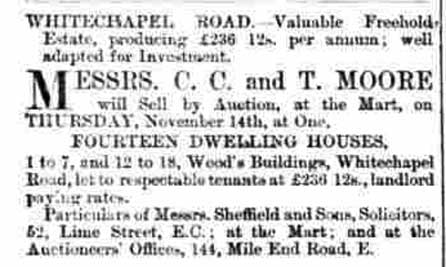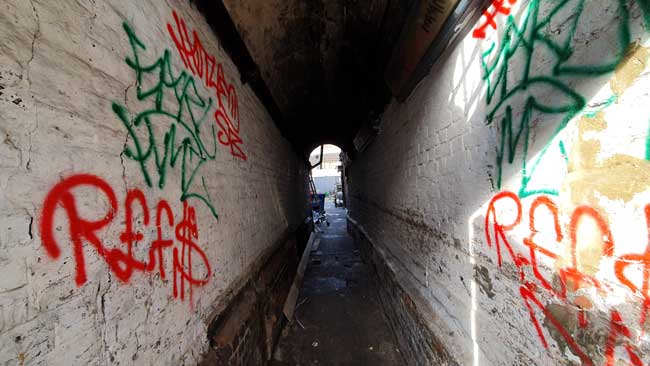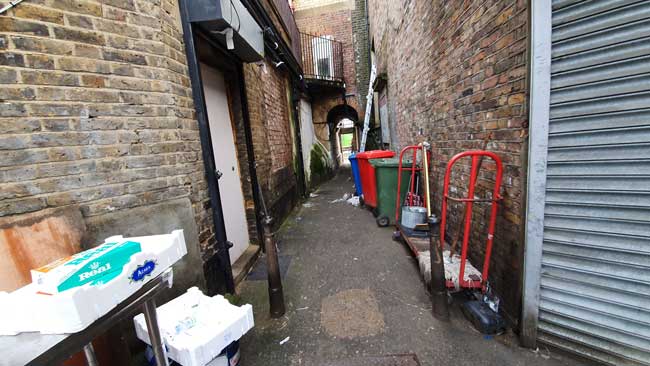- Site Author and Publisher Richard Jones
- Richard Jones
WOOD'S BUILDINGS - WHITECHAPEL ROAD
| Location: Between 263 and 265, Whitechapel Road, E1. |
THE FEEL OF JACK THE RIPPER'S WHITECHAPEL
Wood's Buildings is an easily missed narrow thoroughfare that squeezes between two shops located on Whitechapel Road, directly opposite the Royal London Hospital.
It is entered from Whitechapel Road by way of an 18th century arched passageway, albeit the entrance is now gated and it is almost impossible to venture through it, unless you happen to be passing it on one of those rare occasions on which the gate has been left open.
Should you find yourself able to take a furtive foray into its menacing hinterland, you will find yourself pitched into a gloom-laden throwback to bygone days, and it won't take a great leap of the imagination to picture Jack the Ripper, or some other nefarious monster of ill-intent, lurking in its shadows; and your visit will, by necessity, be a short one, owing largely to the ever present threat that someone might close and lock the gate, leaving you trapped within the court's sinister confines.
AN 18TH CENTURY DEVELOPEMENT
The two shophouses on either side of the entrance to Wood's Buildings were built between 1767 and 1772 by Spitalfields bricklayer Samuel Ireland, and they hold the distinction of being the oldest buildings on this stretch of the north side of Whitechapel Road.
Ireland also developed Wood's Buildings, which was originally a court of eighteen smaller houses, each measuring 13 feet wide by 10 feet deep, and which was entered via the aforementioned arch on Whitechapel Road.
The houses were more of an investment opportunity for private landlords than salubrious residences for proud homeowners, and the properties were often put up for auction as job lots throughout the 19th century, their tenants being poor working people.

A CURIOUS CHARGE OF ABDUCTION
Wood's Buildings managed to keep a low profile for most of the 19th century, albeit, in 1882, it did attract nationwide attention when the daughter of a poor labourer who resided there was the victim of a "curious" case of abduction, from which, reading between the lines, her father may well have profited.
The Birmingham Mail published details of the subsequent court case in its edition of Saturday, 11th March, 1882:-
At the Worship Street Police Court, yesterday, Martin Nally (38), describing himself as a general dealer, Devonshire Place, Whitechapel, was charged on remand with having taken away, out of the possession and against the will of her father and mother, a girl named Elizabeth Ward, under the age of 16 years.
The mother and father of the girl - who is only 15 years and 3 months old - are poor people, living in Wood's Buildings, Whitechapel.
The girl, it appeared from a statement made on the last occasion, had been working for the prisoner, who, besides dealing in general articles, also vended baked potatoes about the streets, and was a maker of firewood.
In the latter work the girl was engaged, and during three years had been employed by the prisoner.
Lately she had taken to stopping away from home until late, and, on the night of the 26th of February, was away altogether.
On the following day the prisoner called on the mother, who had been enquiring after the girl, and told her that he had married her daughter the day before. The girl said that she believed she was married to the prisoner, having gone through a ceremony, but she had not her marriage certificate. The mother gave the prisoner into custody the same night.
The father of the girl now produced the marriage certificate, and said that he had found it was "all right."
Asked by the magistrate if he wanted to go on with the prosecution, he said, "No," adding that he was quite satisfied with the marriage, although the man was so much older.
The father of the girl, an excavator, flourished the marriage certificate, and when Mr. Bushby ordered the prisoner to be discharged, the father and the bridegroom, with the girl, left the court together."
Source: The Birmingham Mail, Saturday, 11th March 1882
THE HOUSES DEMOLISHED
Two years later, in 1884, with the expansion of the East London Railway Line, a new station, Whitechapel and Mile End, was opened, and the houses of Wood's Buildings were pulled down to make way for a bridge over the railway line.
Thereafter Wood's Buildings became little more than a cut through from Whitechapel Road to Winthrop Street, beyond which was Buck's Row, scene of the murder of Mary Nichols, the first victim of Jack the Ripper, on August 31st, 1888.
And that, more or less, is what it remains today, although cutting through it is, sad to say, no longer an option, unless fortune and the gatekeeper happen to smile upon you!

THE HORSE SLAUGHTERERS BREAK
At the inquest into the death of Mary Nichols Henry Tomkins, a horse slaughterer who was working in Winthrop Street at the time of her murder, testified that at 12.20 a.m. that morning, he and two workmates - James Mumford, and Charles Britten - had taken a break and gone for a walk up the court of Wood's Buildings.
They had, he said, seen nothing or no one suspicious in the vicinity, and they had returned to their place of employment at one o'clock in the morning.
JACK THE RIPPER'S ESCAPE ROUTE
In the aftermath of the murder of Mary Nichols, speculation was rife as to how the killer had managed to carry out the foul deed and then simply melt away, unseen by anybody, into the early morning.
But, as several newspapers pointed out, he could have made use of any number of narrow passageways to pass from Buck's Row onto Whitechapel Road, where, according to the coroner at the inquest, Wynne Edwin Baxter, he would have been "lost sight of in the morning's market traffic."
Over the years a belief has sprung up that Wood's Buildings would have provided the most direct route for the perpetrator to have escaped onto Whitechapel Road.

A DRAMATIC TOUR FINALE
When I began my Jack the Ripper guided tour in 1982, Wood's Buildings was always the last point on the tour, and it used to be the passageway by which the walk would leave behind the story of the murders to emerge blinking onto Whitechapel Road and back into the 20th century.
Sadly, in the late 1990s, the passageway became the scene of all manner of nefarious activity that included drug dealing, prostitution, as well as people slipping into it to use it as a public toilet.
In 2004, to put a stop to these anti-social shenanigans, heavy metal gates were erected at both ends of the passage, and public access to it was no longer allowed. And, when access was denied, another little link to 19th century Whitechapel was lost, and Wood's Buildings ceased to provide an atmospheric portal via which those who wished to could slip back into the London of Jack the Ripper.
